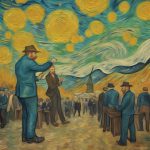How Intellectual Humility and Mass Psychology Fuse into the Sharpest Trading Weapon Alive
Nov 15 2025
The First Pulse: The Crowd, the Chart, and the Mind That Refuses to Lie to Itself
Mass psychology rocks because markets are not machines; they are stampedes disguised as numbers. Every chart shows a crowd trying to negotiate with its own fear. Every candle carries the residue of someone’s anxiety, hesitation, arrogance, or hope. When you merge this with technical analysis, the lines stop being lines. They become nerves. They twitch when the herd tightens. They spasm when the herd snaps. They stretch when the herd pretends it is calm.
Intellectual humility enters like a quiet counterweight, keeping the entire system from turning into ego theatre. A humble mind reads the crowd without joining it. It studies structure without worshipping it. It uses TA as anatomy and mass psychology as the blood flow that makes the anatomy come alive. The trader who carries humility into this landscape does not chase noise. He listens for rhythm. He watches the crowd reveal its next mistake long before it knows it has already made it.
This is not philosophy. This is survival.
The Paradox of Knowing Less and Seeing More
Intellectual humility sounds gentle, but in markets it is a weapon. It forces you to admit that your beliefs about price are provisional. You hold your ideas lightly enough to adjust to the instant reality shifts. You accept that your mind is one against millions, and your conviction is irrelevant to the crowd’s direction. Once you accept that, clarity arrives. Your vision sharpens because you have stopped arguing with the market in your head.
The crowd despises this mindset. Crowds rally around certainty because certainty feels like safety. That is the irony: the moment a trader becomes certain, they become predictable. Predictability is the territory where charts expose you. Patterns form because humans repeat their mistakes with exquisite consistency. A humble mind watches these repetitions without guilt or attachment. It sees the gap between belief and behaviour, and that gap becomes the entry point for profit.
Humility is not doubt. Humility is precision.
The Emergent Beast: How the Crowd Thinks for You
Mass psychology creates a creature with its own desires. Gustave Le Bon described this more than a century ago, and modern behavioural economics keeps proving him right. Put individuals in a crowd and their rationality thins. Their emotional reactions intensify—their need for belonging overrides their need for accuracy. When the group moves, the individual follows. This is the oldest instinct in the species, and markets turn it into visible geometry.
TA identifies these movements with lines that appear mathematical but are actually human. A rising channel shows ambition trying to hide caution. A wedge reveals hesitance, squeezing hope into a narrowing space. A sharp pullback exposes regret. A breakout exposes confession. A reversal exposes shame. The chart does not lie because the crowd cannot lie as a collective. It leaves footprints everywhere.
Humility allows you to see those footprints without projecting fantasy onto them. You are the observer, not the preacher. You are the interpreter, not the believer. You wait until the crowd reveals its mood, then you ride the emotional residue until the next shift. You do not fight sentiment; you harness it.
This is the part traders ignore at their peril.
The Second Pulse: Technique Without Psychology Is Blind
Most TA purists fail because they want patterns to behave like sacred geometry. They want triangles to predict destiny and moving averages to deliver prophecy. That fantasy breaks the moment the price hits a level, and the crowd’s emotion betrays the pattern. A humble mind prepares for betrayal. The crowd always has the final vote.
Every signal gains meaning only when sentiment attaches weight to it. A perfect pattern with an indifferent mood is a corpse that refuses to move. A flawed pattern, driven by emotional pressure, becomes a stampede. TA without mass psychology is a skeleton without breath. Mass psychology without TA is breath without structure. Combine them and you get vision.
This combination is not optional; it is the difference between trading the market you want and the market that exists.
Where Humility Interferes with Herd Madness
The most destructive market failures arise when intellectual humility disappears. Bubbles emerge because crowds prefer fantasy over friction. Crashes strike because nobody wants to question their own narrative. Echo chambers grow because people punish nuance and reward loud certainty.
Humility interrupts these pathologies. It forces you to hesitate before joining the stampede. It allows you to study the herd without absorbing its panic. It lets you step aside when euphoria outruns reality, and step in when despair overshoots value. It brings balance into an environment engineered to destabilise thought.
This is why some traders survive storms that destroy others. They refuse to hallucinate certainty.
The Market as Psychological Mirror
When you watch a price move, you are watching psychology crystallise. Trend continuation is confidence, trying to stretch its limits. Reversals are regret shifting into desperation. Long consolidations reflect indecision masquerading as discipline. Violent wicks show panic, trying to hide behind a brave face.
The humble trader reads this without flattery. You do not assign moral value to patterns. You do not assume your interpretation is flawless. You test, observe, recalibrate. You allow new information to replace old conclusions. This is the psychological flexibility that amplifies the power of TA and enables it to execute mass psychology with accuracy. It creates an internal rhythm that mirrors the market’s external rhythm.
When both rhythms sync, you are no longer guessing. You are listening.
The Third Pulse: How the Two Forces Interact in the Real World
Markets
You see this when bubbles inflate. Doubt gets mocked. Sceptics get sidelined. Certainty becomes the social currency. Intellectual humility becomes rare and therefore priceless. When the crash arrives, humility becomes vindication because it prevented you from drowning in the crowd’s intoxication.
Politics
Polarisation thrives because crowds want simple answers. Humility introduces complexity, which crowds interpret as weakness. The same psychological dynamic that sends a stock vertical sends a nation into ideological fever. The same refusal to question one’s own narrative leads to collective delusion.
Misinformation
Falsehood spreads because crowds prefer emotional speed over cognitive accuracy. Intellectual humility requires slowing down, checking sources, and confronting internal bias. The crowd wants the opposite. The result is a psychological pandemic.
The pattern repeats everywhere because human wiring has not evolved nearly as fast as our systems.
The Dragon’s Mindset: Precision Wrapped in Openness
Your protocol uses the dragon metaphor for good reason. The creature is powerful, disciplined, aware of its limits, and capable of shifting its form without losing its identity. Intellectual humility behaves exactly like this. It takes confidence and tempers it with adaptability. It takes strength and bends it into nuance.
At the personal level, you cultivate humility by interrogating your own certainty. You ask where you might be wrong and what evidence would change your position. You seek disagreement instead of validation. You allow new information to reshape your trajectory.
At the systems level, institutions thrive when they build environments where dissent is safe, evidence outranks charisma, and accuracy outranks noise. Prediction markets, diverse teams, transparent feedback cycles, and distributed decision structures all function as societal versions of intellectual humility.
The Trading Edge: Why This Combo Hits Harder Than Any Indicator
The trader who merges humility with TA and mass psychology gains an edge that feels unfair. You hear the crowd breathing before it screams. You feel pressure building before volatility erupts. You recognise exhaustion before reversal. You sense consensus tightening into fragility. You move with the tide instead of drowning in it.
You do not chase. You wait. You do not predict. You read. You do not cling. You adjust.
This combination separates the profitable from the casualties. It is not mystical. It is psychological accuracy supported by structural analysis.
This is the killer combo.
The Final Pulse: The Dance That Never Ends
The crowd moves as one creature. The chart records its footprints. Humility protects you from stepping into the creature’s jaws. TA shows you where the beast tends to strike. Mass psychology shows you why it strikes. All three together form a rhythm that never repeats exactly but always rhymes.
Mastering that rhythm is not a trick. It is a practice.
Ignore this combination and the market punishes you without mercy. Embrace it, and the market reveals itself with clarity that feels like magic, though nothing magical has occurred. You simply learned to see what others refuse to admit.
This is the dance.
This is the edge.
This is the weapon.
The Blueprint for Bold Thinking











